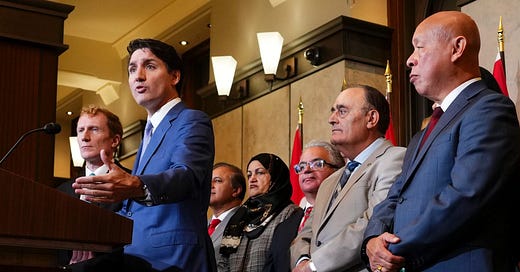Bulls in a china shop.
Increasingly politicized, abrupt, and short-sighted immigration policies changes are wreaking havoc across the country, and it's not pretty.
Smash and Dash
Today, the federal government took another stab at cutting down immigration; slashing permanent resident targets by 21%. Federal Minister of Immigration, Marc Miller, announced his new Immigration Levels Plan 2025-27, which broke down how the government will cut intake in permanent residents by nearly a quarter in 2025.
In this plan, next year’s target for Permanent Residents will drop down to just 395,000 (a loss of 105,000 spaces). This snowball effect is set to continue further in 2026 (down to 390,000) and 2027 (down to 365,000).
In a strange one-two dance routine, Prime Minister Trudeau precedent Miller’s announcement with a declaration that “now is the time to make adjustments to stabilize the immigration system that we need”.
Shotgun Policy
Let’s not forget that the feds have been blasting the immigration sector to bits for the past year. Starting this past January, with the 35% cut in study permits (which all but destroyed private-public partnerships at community colleges). Then last month with a round of buckshot to the heart of higher education: new grad student cap, post-graduate work permit restrictions, and a further 10% cut in study permits (which will virtually kill off any change for public colleges to recruit international students). Rumours have it that the sector is bracing for a 70-80% drop in international enrolments this year alone. Remember how the original target was precisely at “bad actors”. Now we’re talking about sector-wide damage. Shotgun policy indeed.
Why Now?
Minister Miller’s latest announcement marks — once again — an unprecedented shift in immigration policy, and a completely reversal of the government’s previous tack. Just last year, the feds announced an increase in permanent resident intake to 500,000. But this year, it’s a 120,000 cut in available spaces over the next 3 years. Such erratic and drastic changes can only have jarring impacts in the months and years to come,
According to the Minister, the need is “to focus on the people that are already here”, and that this policy is all about reducing demands on healthcare, immigration services, and — more importantly — housing. “The permanent resident targets are expected to impact the housing supply gap by 670,000 units by the end of 2027, so we won’t have to build an additional 670,000 units by that time.”
Who Will This Policy Harm the Most?
An odd assumption, particularly as those most directly impacted by this policy — are the thousands of international students currently living in Canada. Those hit hardest will be those international students who don’t fit into an Express Entry category (of STEM, healthcare, agriculture, trades, transport or French). Keep in mind, that according to Statistics Canada, 6 in 10 international students with work experience become permanent residents in a decade, contributing billions to the economy in jobs generated and dollars spent. With a 21% cut in the number of permanent residence spots, how many skilled graduates will start leaving the country to look elsewhere for opportunity?
Before these first announcements, international students and recent graduates represented nearly half of the total 2.5 million temporary residents living in Canada in 2023. However, after two crackdowns on study permit caps, restrictions to post-graduation pathways, cuts in temporary resident numbers, and now far fewer opportunities for permanent residency, the message from the federal government is starting to become rather clear for skilled immigrants: “We do not want you”.
An Immigration Plan to Cry For
This policy — to cut down the number of Permanent Residents year-on-year — will not only hurt thousands of students currently studying in Canada, but long term — will only drive away top talent, kneecap economic growth, and weaken our workforce supply. Keep in mind that this new plan aims to reduce Canada’s temporary resident population down to 5.2% (from 6.5%) …all by 2026. You don’t make that sharp drop without considerable bloodshed.
Stakeholders have suggested that this policy is not only politically motivated, but short-sighted. According to CBIE President and CEO, Larissa Bezo: “We are now at great risk as a country in seriously hampering our ability to recruit and retain the high-quality global talent that Canada so desperately needs to address our labour market and demographic realities, thereby jeopardising our long-term growth and prosperity.”
Already we’re seeing the havoc wrought by these coupled immigration announcements, with Ontario universities projecting nearly $1 billion in lost revenue. Students from Canada’s greatest source of international talent, India, are now actively seeking out other countries in which to study, including the USA, UK, and others.
In the coming days, I’ll look into some interesting best practices from other OECD countries in how they’re responded to immigration challenges within the education sector…without resorting to shotgun policy (mostly). At the frantic speed this government’s moving, it’s all one can do to simply analyse their latest blast of announcements, much less, provide actionable, alternative policy solutions. More to come!





